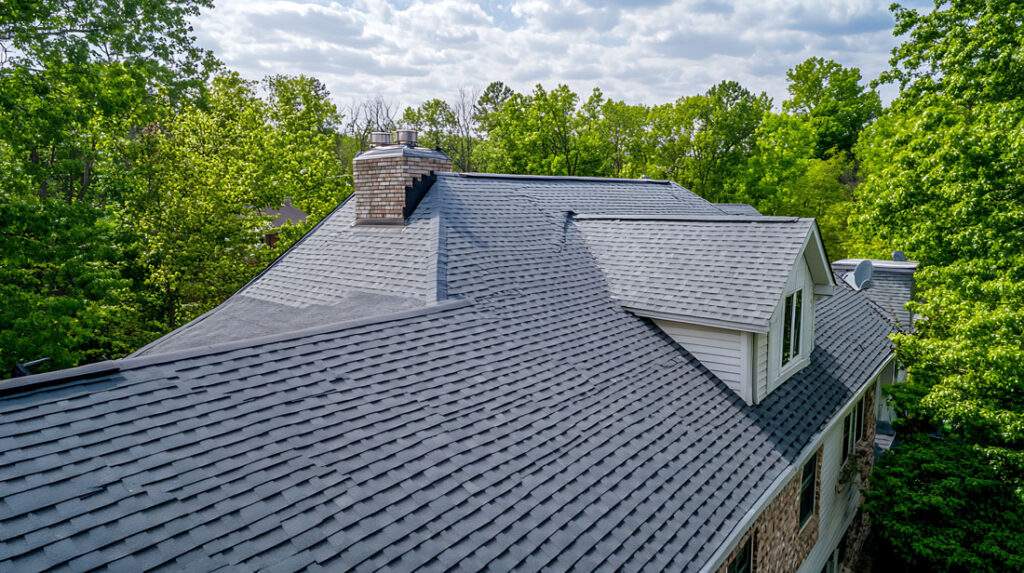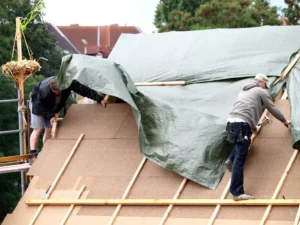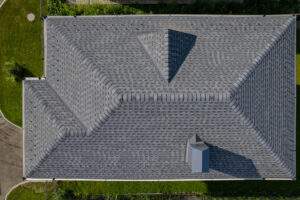Roofing problems escalate quickly in Fargo’s winters. At Allstar Construction, we build every shingle to withstand Fargo’s icy winds and hail.
In this blog post, you’ll understand why fall is the best time to assess your shingles right before winter hits full force. So, ready to spot the signs?
Let’s break down the essentials—no need to guess when it’s Allstar-backed confidence.
Key Takeaways
- Fall is the best time to inspect shingles, preventing winter damage and avoiding expensive repairs.
- Visible shingle issues like wavy patterns or missing shingles hint at wind or prior installation problems worth addressing.
- Granules in gutters mean shingles are wearing out, signaling it’s time to consider a full replacement, not just repairs.
- Dark spots or moss growth on shingles can indicate moisture issues and poor ventilation, leading to further roof damage.
- Indoor signs like water stains or drafts suggest shingle damage, letting in water or air and requiring professional inspection.
Why Fall is the Best Time to Check Your Shingles (Before Winter Strikes)
Fargo’s winters don’t hold back, and your shingles bear the brunt.
A proactive fall roof inspection isn’t just smart—it’s necessary. When temperatures drop, here are the consequences you’ll likely face:
- Water damage from melting snow can escalate and ruin interior structures.
- Missed issues by contractors can force repeat roof repairs when you least expect it.
- Winter repair costs are higher, thanks to harsher conditions.
At Allstar Construction, we believe quality work is about more than quick fixes. A thorough fall check helps us catch what others might miss, setting you up for a worry-free winter.
Signs Your Shingles Need Attention: Spot Them in 5 Steps
Spotting the warning signs early keeps your roof in shape without costly surprises. Use these steps to check your shingles and catch any issues before they escalate:
Step 1. Start by Looking from Afar
Begin your home inspection with a distant view of the roof.
Look for obvious issues like wavy patterns or missing shingles across larger sections. Loose or lifted shingles visible from the ground might signal wind damage, or worse, point to substandard installation from a previous job.
Observing from afar helps spot tell-tale signs and prepares you for a closer inspection.
Step 2. Focus on the Shingles’ Edges
Next, examine the edges of your shingles—this is where signs of winter damage often appear first.
Look for curling, cracking, or any visible wear. Damaged edges mean the shingles are deteriorating, which often happens if previous repairs don’t adequately shield them.
Spotting these signs early can prevent issues, as edges are more vulnerable to further weather damage.
Step 3. Check for Granules in the Gutters
After a storm, take a peek inside your gutters.
If you find a buildup of granules, it could mean your shingles are losing their protective layer. This loss usually points to aging or poor-quality shingle materials that won’t hold up long-term.
A consistent granule presence in your gutter may clog it up, suggesting a clear sign that it’s time for a full replacement, not just another repair.
Step 4. Inspect for Dark Spots and Moss Growth
Dark spots or patches of moss on your shingles can signal trapped moisture or hidden damage beneath the surface.
Moss isn’t just unsightly. Recurring growth often hints at the need for proper roof ventilation, especially if previous repairs didn’t address airflow issues. Ignoring this can lead to more moisture build-up, weakening the shingles.
Catching these early helps prevent further problems and keeps your roof looking clean and intact.
Step 5. Get Up Close to Assess Individual Shingles
For those comfortable with a ladder, check individual shingles up close.
Press gently—shingles should feel firm, not soft or spongy. Softness or signs of rot could mean water has seeped beneath, often from improper roof installation or aging materials.
This hands-on check makes sure no hidden damages are worsening beneath the surface—a smart step toward long-lasting roof health.
Listen for Clues: When Your Roof Speaks Up
Beyond these surface signs, some roof issues may not be obvious at first glance. Sometimes, other signs are subtle but still hint at trouble ahead.
Outdoor Warning Signs
Pay attention to unexplained damp areas on exterior walls, especially after rain. If you notice water pooling near your home’s foundation or suspect drainage issues, it could indicate damaged shingles failing to direct water away.
For homeowners ‘left in the dark,’ these clues help you stay ahead of roof health issues before they become costly repairs.
Indoor Clues
Water stains on your ceiling or walls? These mean your shingles aren’t holding up as they should. What about a sudden draft or unexpected indoor temperature changes? Damaged shingles or gaps may be letting in outside air.
Instead of patching the symptom yourself, hire professional roofers like Allstar Construction to tackle the issue at the source and prevent leaks that could worsen with time.
A Simple Checklist for Your At-Home Inspection
Doing an at-home roof check can be quick and effective. This quick checklist can guide you through an at-home inspection, helping you pinpoint any early signs of trouble.
Here’s what to look for:
DIY Checklist
- From the Ground: Stand back and observe your roof’s overall appearance. Look out for any irregular patterns or missing shingles that might indicate potential issues from previous installations or weather damage.
- Attic Check: Take a trip to your attic during the daytime. Look for any light filtering through the roof and signs of dampness or water stains. These suggest that your shingles might not be providing a complete seal.
- Skylights and Chimneys: Inspect the areas around skylights and chimneys. Gaps, wear, or cracks around these features are often hotspots for leaks, especially during heavy snow or rain.
Confidence Through Every Season with Allstar Construction’s Quality Approach
With Allstar Construction, you’ll never face another rushed job or unexpected repair bill. Our commitment to quality means each shingle is placed with care and precision, designed to stand strong through Fargo’s intense seasons.
If you’ve spotted any signs of wear, don’t leave it to chance. Contact us at 701-461-7661 or 218-275-6298 to schedule an inspection, and let us handle the rest. Get the peace of mind you deserve this winter.






